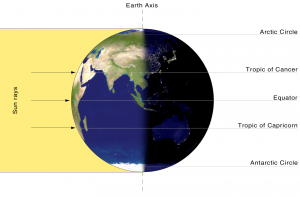Today, at approximately 1:32 p.m. EDT, the Sun will be on the celestial equator, in the constellation Pisces. It will then be at the position known as the first point of Aries. (Makes sense, right? If you’re in Pisces, you pretend to be in Aries. Chalk this one up to the effects of precession.)
Here is an illustration from Wikipedia of the orientation of the Earth relative to the Sun’s rays on the equinox:
This alignment occurs, not because the Earth’s axis is any more or less tilted than it ever is (23.5 degrees from the ecliptic plane), but because the Sun’s position is at the intersection of the ecliptic and the celestial equator.
Starting tonight, the Sun will set slightly north of due west; just how far north it will go depends on your distance from Earth’s own equator. It will move 23.5 degrees to the north, when, at the June solstice, it will have reached its ascending node and start descending to the south.
Even though the term equinox is derived from the Latin for “equal night,” the lengths of day and night are NOT equal on the equinoxes. This is due to two easily observable phenomena:
- The Sun is not a point source of light.
- Atmospheric refraction changes the apparent position of the Sun relative to your horizon.
For more on this, see my post about the September equinox.



1 thought on “March equinox”